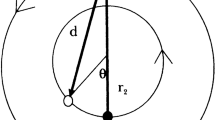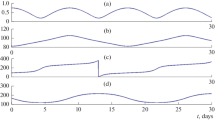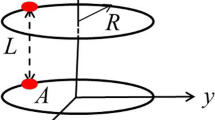Abstract
The present study examines the behavior of a classical charged point particle in near-elliptic orbits about an infinitely massive and oppositely charged nucleus, while acted upon by applied electromagnetic radiation. As recently shown for near-circular orbits, and now extended here to the elliptical case, rather surprising nonlinear dynamical effects are readily produced for this simple system. A broad range of stability-like conditions can be achieved by applying radiation to this classical atom. A perfect balance condition is examined, which requires an infinite number of plane waves representing harmonics of the orbital motion. By applying a scale factor to this radiation, stability-like conditions are produced where periodic variations in semimajor and semiminor axes occur for extended periods of time, before orbital decay eventually takes over due to the effects of radiation reaction. This work is expected to lead to both practical suggestions on experimental ideas involving controlling ionization and stabilization conditions, as well as hopefully aiding in theoretical explorations of stochastic electrodynamics.
Similar content being viewed by others
REFERENCES
Cole, D. C., and Zou, Y. (2004). Simulation study of aspects of the classical hydrogen atom interacting with electromagnetic radiation: Circular orbits. J. Sci. Comput. 20(1), 43–68.
Grochmalicki, J., Lewenstein, M., and Rzazewski, K. (1991). Stabilization of atoms in superintense laser fields: Is it real? Phys. Rev. Lett. 66(8), 1038–1041.
Griffiths, J. A., and Farrelly, D. (1992). Ionization of Rydberg atoms by circularly and elliptically polarized microwave fields. Phys. Rev. A 45(5), R2678–R2681.
Braun, P. A. (1993). Discrete semiclassical methods in the theory of Rydberg atoms in external fields. Rev. Mod. Phys. 65(1), 115–161.
Clark, W., and Greene, C. H. (1999). Adventures of a Rydberg electron in an anisotropic world. Rev. Mod. Physics 71(3), 821–833.
Yoshida, S., Reinhold, C. O., Kristofel, P., and Burgdorfer, J. (2000). Exponential and nonexponential localization of the one-dimensional periodically kicked Rydberg atom. Phys. Rev. A 62, 023408.
Wesdorp, C., Robicheaux, F., and Noordam, L. D. (2001). Displacing Rydberg electrons: The mono-cycle nature of half-cycle pulses. Phys. Rev. Lett. 87(8), 083001.
Gallagher, T. F., Hill, R. M., and Edelstein, S. A. (1978). Method and apparatus for field ionization for isotope separation, US Patent No. 4,070,580; see: www.uspto.gov, pp. 1–7.
Bir, R., and Schermann, J. P. (1982). Method of isotope separation, US Patent No. 4,360,501; see: www.uspto.gov, pp. 1–6.
Oomori, T., Ono, K., and Fujita, S. (1990). Ion current generator system for thin film formation, ion implantation, etching and sputtering, US Patent No. 4,893,019; see: www.uspto.gov, pp. 1–43.
Oomori, T., and Ono, K. (1992). Ion source, US Patent No. 5,115,135; see: www.uspto.gov, pp. 1–75.
Noordam, L. D., and Lankhuijzen, M. D. (2000). Apparatus for detecting a photon pulse, US Patent No. 6,049,079; see: www.uspto.gov, pp. 1–9.
Cole, D. C. (1993). Reviewing and Extending Some Recent Work on Stochastic Electrodynamics, World Scientific, Singapore, pp. 501–532.
de la Peña, L., and Cetto, A. M. (1996). The Quantum Dice—An Introduction to Stochastic Electrodynamics, Kluwer Academic Publishers, Kluwer Dordrecht.
Boyer, T. H. (1975). Random electrodynamics: The theory of classical electrodynamics with classical electromagnetic zero–point radiation. Phys. Rev. D 11(4), 790–808.
Boyer, T. H. (1985). The classical vacuum. Sci. American 253, 70–78.
Uzer, T., Farrelly, D., Milligan, J. A., Raines P. E., and Skelton, J. P. (1991). Celestial mechanics on a microscopic scale. Science 253(42), 42–48.
Becker, R. A. (1954). Introduction to Theoretical Mechanics, McGraw–Hill, New York.
Goldstein, H. (1981). Classical Mechanics, 2nd ed., Addison–Wesley, Reading, MA.
Fine, H. B., and Thompson, H. D. (1918). Coordinate Geometry, The Macmillan Company, Norwood, MA.
Gradshteyn, I. S., and Ryzhik, I. M. (1980). Tables of Integrals, Series, and Products, Academic, New York.
Press, W. H., Teukolsky, S. A., Vetterling, W. T., and Flannery, B. P. (1992). Numerical Recipes in C: The Art of Scientific Computing, 2nd ed., Cambridge University Press, New York.
Author information
Authors and Affiliations
Rights and permissions
About this article
Cite this article
Cole, D.C., Zou, Y. Simulation Study of Aspects of the Classical Hydrogen Atom Interacting with Electromagnetic Radiation: Elliptical Orbits. Journal of Scientific Computing 20, 379–404 (2004). https://doi.org/10.1023/B:JOMP.0000025930.62480.05
Issue Date:
DOI: https://doi.org/10.1023/B:JOMP.0000025930.62480.05




